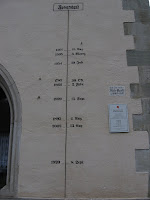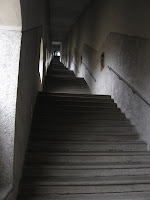Since November my workload has suddenly picked up a lot, but I still could not resist the temptation to sneak out for a day trip. So I happily accepted the invitation from a friend to visit her in Passau and went there with a couple of other guys. This friend of mine has visited me back in June and has now started studying at the University of Passau.
十一月以來,工作應接不暇,但十二月初還是應了一個德國朋友之邀,忙裡愉閒跟另兩個朋友到巴伐利亞州東部城市帕紹(Passau) 遊玩一天。這個德國朋友,六月曾來探訪,今年秋天起到帕紹唸大學。
Passau is also known as the City of Three Rivers, and is physically located at the tip of a peninsula where the three rivers meet, namely the Danube, the Inn (which flows through many places including Innsbruck) and the Ilz. The Danube lies north of the peninsula, with a narrower surface, stronger current but fortunately a deeper river bed which makes the river more suitable for shipping.
帕紹又稱三河之城,城理上位處一個半島的尖端,尖端處是三條河匯流的地方——計有多瑙河(Danube)、茵河(Inn,上游流經多個城市包括茵斯布魯克Innsbruck)及伊爾茨河(Ilz)。半島北面的多瑙河,河面較窄,水流較急,但勝在河床較深,所以較適合大型的船隻通過。

From the Danube, we wandered through the University and came across the Inn on the south side of the peninsula. The Inn is wider and more tranquil compared to the Danube, and forms a most perfect place for relaxing and studying alike. The University of Passau is really blessed to have a backyard like this!
從多瑙河經過帕紹大學來到半島南面的茵河,那裡河面較寬,水流較慢,環境恬靜,帕紹大學有這個後花園,不論休憇或做學問,都饒有風味。

Buildings of the University of Passau, formerly a monastery
帕紹大學的大樓,前身是修道院。


Left: Philosophy by the Inn 左:茵河畔的哲學
Crossing the Fünfersteg bridge over the Inn, we reached the town of Innstadt. My friend tried to draw some parallels between Innstadt and Italy with regard to the winding narrow streets and the architectural style of the buildings.
朋友帶我們走過Fünfersteg橋,便來到茵河對岸的Innstadt,朋友介紹說Innstadt的街道和房子都有點意大利風格。
Fünfersteg bridge
Fünfersteg橋


Looking towards the Innbrücke (left) and the railway bridge (right) on either side of Fünfersteg
Fünfersteg橋兩邊的茵河橋(左)和鐵路橋(右)

Houses beside the bridge
橋邊的房屋
Crossing the Fünfersteg bridge over the Inn, we reached the town of Innstadt. My friend tried to draw some parallels between Innstadt and Italy with regard to the winding narrow streets and the architectural style of the buildings.
朋友帶我們走過Fünfersteg橋,便來到茵河對岸的Innstadt,朋友介紹說Innstadt的街道和房子都有點意大利風格。

Severintor (The Gate of Severin)
Severin城門


Ledergasse in Innstadt Innstadt的皮革街
Over the hill of Innstadt stood the Church of Mariahilf (literally Mary’s Help). It was the place where one of the Austrian emperors sought refuge during a Turkish invasion, and legend has it that the emperor was praying for Saint Mary’s ‘divine intervention’ to help drive out the Turkish troops. The emperor got what he wanted, and since then many others followed suit, including many university students before their exams!
Innstadt山上有座Mariahilf教堂(直譯可稱為瑪利亞保祐堂),據說土耳其人攻佔奧地利時,當時的奧地利皇帝落荒而逃,來到帕紹,甚麼都無能為力,祇好每天向聖母禱告,祈求土耳其人早日敗陣而回,結果得償所願,所以時至今日仍有人造訪此教堂,祈求心想事成,包括不少應試的帕紹大學學生!
Church of Mariahilf on the hill
山上的Mariahilf教堂
A test of will before seeing Saint Mary 測試信眾意志的階梯
The Church itself (left) and the statue of Saint Mary (right)
教堂(左)和聖母像(右)
The view of the Inn and the Oberhaus fortress from Mariahilf
從教堂遠望茵河及山上的Oberhaus堡壘
Descending from the Church of Mariahilf, we crossed the Innbrücke and were back in the city centre. After lunch, my friend took us to the very tip of the peninsula known as the Tip of Three Rivers (Dreiflüsseeck) for a view of the confluence of all three rivers.
從Mariahilf教堂下山,走過茵河橋,回到帕紹市中心逛逛。午飯後朋友帶我們一直到半島最尖端的三河角(Dreiflüsseeck),欣賞三河匯聚之景。
Innbrücke
茵河橋



Around the city
市區的街道


Christmas decorations 聖誕裝飾


Town hall 市政廳


The Oberhaus fortress and the Luitpoldbrücke at its foot
Oberhaus堡壘及其山腳的Luitpold橋


The view of the confluence on a bright sunny day (left) and an overcast day like that day (right)
三河匯流——晴天(左)和我們那天陰天的景色(右)

Schaiblingsturm by the Inn
茵河畔的Schaibling塔

The mouth of the Ilz
Ilz河口
 The sight is nice to enjoy, but can be nasty when it floods. Passau can be left thoroughly drenched when the rivers on both sides flood at the same time, and the highest historical water levels were chronicled on a chart beside the main entrance of the town hall. Apparently Passau has such a reputation from these extraordinary submersions that my friend got asked on many occasions, ‘Are you going to the place that always floods?’ when she first moved to Passau.
The sight is nice to enjoy, but can be nasty when it floods. Passau can be left thoroughly drenched when the rivers on both sides flood at the same time, and the highest historical water levels were chronicled on a chart beside the main entrance of the town hall. Apparently Passau has such a reputation from these extraordinary submersions that my friend got asked on many occasions, ‘Are you going to the place that always floods?’ when she first moved to Passau.河景雖美,但萬一河水泛濫時,帕紹受兩面夾擊,水淹可不鬧着玩的,市政廳正門旁的牆上,便刻了歷史上水淹時最高的水位,那個德國朋友也說,她告訴人家要去帕紹唸書時,人家都會打趣問:「那是不是時常有水淹的地方呀?」
Then we visited the St. Stephen’s Cathedral (Dom St. Stephan). We had the fortune to hear the rehearsal of the Regensburger Domspatzen (Regensburg Cathedral Choir) who was supposed to perform later that day.
然後我們到聖士堤反教堂參觀,那天剛好有來自雷根斯堡的教會合唱團(Regensburger Domspatzen,在德國很有名)獻唱,那時合唱團正在排練,我們便有幸欣賞他們的唱功。


The interior of the Cathedral 大教堂內部

The Regensburger Domspatzen
雷根斯堡的教會合唱團
The Christmas Market was right outside the main entrance of the Cathedral, and after a wander through the stalls, it was getting quite late (only because it gets dark so early in winter) and was time to head back to Munich. It’s a pity because there’s supposed to be much more to do around Passau in summer. A favourite among the people is to cycle along the Danube, even all the way to the Austrian city of Linz about 70 km away. What a way it would be to enjoy the nature!
教堂正門外擺了聖誕市集,我們在那裡流連了一會,時間也不早(雖叫冬天這麼早便天黑?)我們便要乘車回慕尼黑,其實也有點可惜,要是至夏天前去的話,可沿着多瑙河踏腳踏車遊玩,甚至一直到70公里外的奧地利城市林茲(Linz),那是多寫意呀!

The front of the Cathedral
大教堂正門


Christmas Market 聖誕市集






Comments
Every time I drop by, I get stunned.
Wish you a Merry Christmas, Geoffrey.